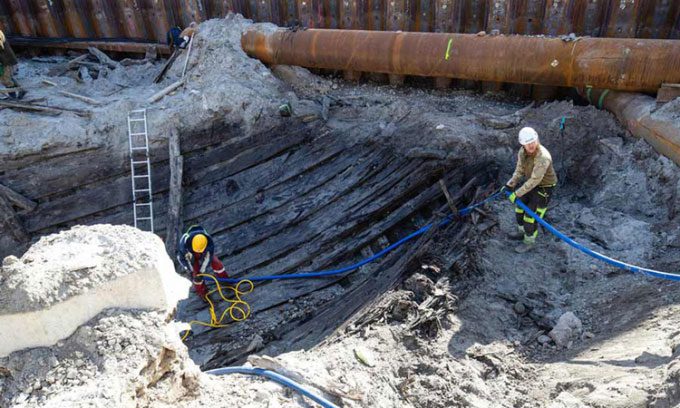A 24-meter long and 9-meter wide oak merchant shipwreck has been discovered buried beneath the city of Tallinn, which once sank beneath the sea hundreds of years ago.
One of the largest ports in the Baltic Sea, Tallinn port is also one of the oldest in Northern Europe. On April 20, a 700-year-old shipwreck belonging to the Hanseatic League was found at a depth of 1.5 meters beneath the streets of Tallinn, the capital of Estonia. At its peak, the Hanseatic League nearly monopolized all maritime trade in the North Sea and the Baltic Sea during the Middle Ages.

The Hanseatic merchant shipwreck located 1.5 meters beneath the streets of Tallinn, Estonia. (Photo: Patrik Tamm/ERR)
This is the largest shipwreck of its kind ever discovered. The ship’s resting place is near the old Harjapea River mouth, a waterway that no longer exists. It was accidentally discovered during the construction of an office building on Lootsi Street in Tallinn. Construction work is expected to be delayed for at least two months to allow archaeologists to excavate the site.
The newly discovered shipwreck is so well-preserved that it may surpass the preservation record of the medieval Bremen Cog. The Bremen Cog was discovered in the Weser River, Germany, in 1962. Experts spent nearly 40 years reconstructing it and displaying it at the German Maritime Museum. Wood dating analysis shows that the Hanseatic ship dates back to 1298, which is 82 years older than the Bremen Cog.
“The Tallinn shipwreck is in much better condition compared to the Bremen Cog. The ship is 24 meters long and 9 meters wide. The planks from the bottom of the ship rise 3 meters and are still intact. The ship was constructed from large oak planks and logs. It has overlapping planks sealed with animal fur and tar,” said archaeologist Mihkel Tammett.
“We also found wool material used for packing, some tools, and pieces of medieval leather shoes. The excavation is ongoing, and we hope to discover even more,” Tammett added.

The 24-meter long and 9-meter wide merchant shipwreck in a construction site in Tallinn. (Photo: Patrik Tamm/ERR)
In 2008, another shipwreck was found about 50 meters from the current Tallinn shipwreck. There are many shipwrecks around Tallinn because the entire area was once underwater until the late 18th century. In the 13th century, it was submerged under 2 meters of seawater.
By the late 1930s, the area around Tallinn was filled with ash and household waste. Ships may have been deliberately sunk here or gradually buried over time. “There may be shallow sandbars that are difficult to map because they change shape and position due to ice drift and storms. The newly discovered shipwreck is located in one of these sandbars beneath the sediment layer,” Tammett said.
Despite its bulky size, the Hanseatic merchant ship was favored for its flat bottom, large cargo space, and ease of operation. However, its large size makes it nearly impossible for experts to move it as a single piece, according to Ragnar Nurk, an archaeologist with the Tallinn city government. “There are currently two main options: it will either be taken to the maritime museum or to a shipwreck preservation area in Tallinn Bay, near Naissaar Island,” he noted.





















































